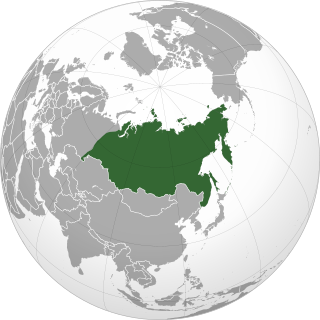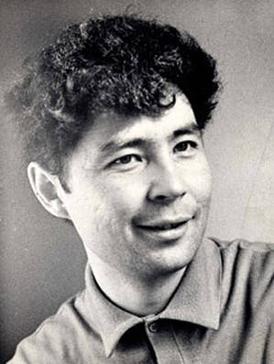
Siberia is an extensive geographical region comprising all of North Asia, from the Ural Mountains in the west to the Pacific Ocean in the east. It has formed a part of the sovereign territory of Russia and its predecessor states since the centuries-long conquest of Siberia, which began with the fall of the Khanate of Sibir in the late 16th century and concluded with the annexation of Chukotka in 1778. Siberia is vast and sparsely populated, covering an area of over 13.1 million square kilometres (5,100,000 sq mi), but home to roughly a quarter of Russia's population. Novosibirsk, Krasnoyarsk, and Omsk are the largest cities in the area.

The Angara is a major river in Siberia, which traces a course through Russia's Irkutsk Oblast and Krasnoyarsk Krai. It drains out of Lake Baikal and is the headwater tributary of the Yenisey. It is 1,849 kilometres (1,149 mi) long, and has a drainage basin of 1,039,000 square kilometres (401,000 sq mi). It was formerly known as the Lower or Nizhnyaya Angara. Below its junction with the Ilim, it was formerly known as the Upper Tunguska and, with the names reversed, as the Lower Tunguska.

Irkutsk is the largest city and administrative center of Irkutsk Oblast, Russia. With a population of 587,891 as of the 2010 Census, Irkutsk is the 25th-largest city in Russia by population, the fifth-largest in the Siberian Federal District, and one of the largest cities in Siberia.

The Trans-Siberian Railway, historically known as the Great Siberian Route and often shortened to Transsib, is a large railway system that connects European Russia to the Russian Far East. Spanning a length of over 9,289 kilometers, it is the longest railway line in the world. It runs from the city of Moscow in the west to the city of Vladivostok in the east.

Irkutsk Oblast is a federal subject of Russia, located in southeastern Siberia in the basins of the Angara, Lena, and Nizhnyaya Tunguska Rivers. The administrative center is the city of Irkutsk. It borders the Republic of Buryatia and the Tuva Republic in the south and southwest, which separate it from Khövsgöl Province in Mongolia; Krasnoyarsk Krai in the west; the Sakha Republic in the northeast; and Zabaykalsky Krai in the east. It had a population of 2,370,102 at the 2021 Census.

The early history of Siberia was greatly influenced by the sophisticated nomadic civilizations of the Scythians (Pazyryk) on the west of the Ural Mountains and Xiongnu (Noin-Ula) on the east of the Urals, both flourishing before the common era. The steppes of Siberia were occupied by a succession of nomadic peoples, including the Khitan people, various Turkic peoples, and the Mongol Empire. In the Late Middle Ages, Tibetan Buddhism spread into the areas south of Lake Baikal.

Yermak Timofeyevich was a Cossack ataman and is today a hero in Russian folklore and myths. During the reign of the Russian tsar Ivan the Terrible, Yermak started the Russian conquest of Siberia.
Mathias or Matthias Hedenström, also known by his Russian name Matvei Matveyevich Gedenshtrom, was a Russian explorer of Northern Siberia, writer, and public servant.

The Nizhnyaya Tunguska is a river in Siberia, Russia, that flows through the Irkutsk Oblast and the Krasnoyarsk Krai. The river is a right tributary of the Yenisey joining it at Turukhansk. The ice-free period on the Nizhnyaya Tunguska starts in mid-June and ends in the first half of October. The river forms the western limit of the Lena Plateau.

The Soyot are an ethnic group of Samoyedic and Turkic origin who live mainly in the Oka region in the Okinsky District in Buryatia, Russia. They share much of their history with the Tofalar, Tozhu Tuvans, Dukha, and Buryat; the Soyot have taken on a great deal of Buryat cultural influence and were grouped together with them under Soviet policy. Due to intermarriage between Soyots and Buryats, the Soyot population is heavily mixed with the Buryat. In 2000, they were reinstated as a distinct ethnic group.

Vladimir Afanasyevich Obruchev was a Russian and Soviet geologist who specialized in the study of Siberia and Central Asia. He was also one of the first Russian science fiction authors.

Valentin Grigoryevich Rasputin was a Soviet and Russian writer. He was born and lived much of his life in the Irkutsk Oblast in Eastern Siberia. Rasputin's works depict rootless urban characters and the fight for survival of centuries-old traditional rural ways of life, addressing complex questions of ethics and spiritual revival.

Alexander Valentinovich Vampilov was a Soviet playwright. His play The Elder Son was first performed in 1969, and became a national success two years later. Many of his plays have been filmed or televised in Russia. His four full-length plays were translated into English and Duck Hunting was performed in London and Washington DC.

Western Siberia or West Siberia is a region in North Asia. It is part of the wider region of Siberia that is mostly located in the Russian Federation, with a Southern part in Kazakhstan. It lies between the Ural region and the Yenisei River, which conventionally divides Siberia into two halves.

The Northern river reversal or Siberian river reversal was an ambitious project to divert the flow of the Northern rivers in the Soviet Union, which "uselessly" drain into the Arctic Ocean, southwards towards the populated agricultural areas of Central Asia, which lack water.

Siberian regionalism was a political movement that advocated for the formation of an autonomous Siberian state. The idea originated in the mid-19th century and reached a high tide with the White movement military activities of Aleksandr Kolchak (1874–1920) and Viktor Pepelyayev (1885–1920) during the Russian Civil War of 1917–1922.

Sergey Pavlovich Zalygin was a Soviet writer and environmentalist, the first non-Communist Party editor-in-chief of the monthly literary magazine Novy Mir (1986–1998).
Russkoye Ustye is a rural locality, the only inhabited locality, and the administrative center of Russko-Ustinsky Rural Okrug of Allaikhovsky District in the Sakha Republic, Russia, located 120 kilometers (75 mi) from Chokurdakh, the administrative center of the district. Its population as of the 2010 Census was 157, down from 181 recorded during the 2002 Census. For several decades during the Soviet era, it was officially called Polyarnoye (Поля́рное).

The East Siberian Laika is a Russian laika of spitz type, a hunting dog originating in parts of Siberia east of the Yenisei River.

Nikolai Mikhailovich Yadrintsev was a Russian public figure, explorer, archaeologist, and Turkologist. His discoveries include the Orkhon script, Genghis Khan's capital, Karakorum and Ordu-Baliq, the capital of the Uyghur Khaganate. He was also one of the founding figures of Siberian regionalism.


















